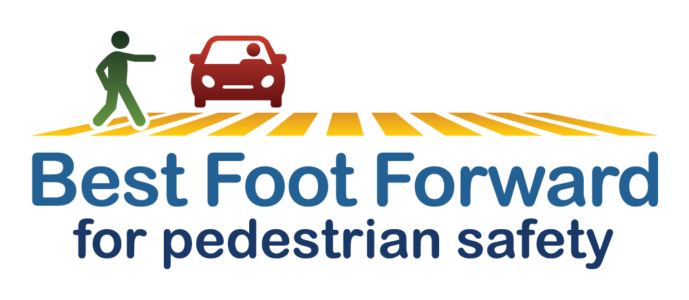ORLANDO, FL – As students throughout Central Florida prepare for a return to the classroom,…

One Less Parking Spot Equals More Eyes on Crosswalk Users
You can’t see what you can’t see. That was the case with a crosswalk in College Park along Edgewater Drive. It involved a parallel parking spot on the street. When a car was parked there, other drivers could not see a crosswalk when making a righthand turn, at least not until they were nearly right on top of the crosswalk.
The solution? Remove the parking spot. It is a prime example of low-cost engineering that resulted in driver behavior change, simply by drivers being able to see more of what’s ahead.

Before

After
Identifying the Problem
How did this change happen? Tony Calabro, a Best Foot Forward data collector, was at that crosswalk at Edgewater Drive and Shady Lane, doing some follow-up study. What he saw caused concern.
Here’s a little bit about Edgewater Drive. It is the main thoroughfare through a trendy area called College Park. It is home to unique retailers, churches, two bicycle shops and many other locally based businesses. In 2015, the corridor was transformed from four lanes into a three-lane road with bicycle lanes and on-street parking. The speed limit is now 30 mph. It was part of a program called Complete Streets, which allows the roadway to offer other transportation options, beyond just the usual car traffic. Within the past year, the City of Orlando also installed a rectangular rapid flashing beacon (RRFB) with yellow flashing lights that alerts drivers to the presence of people trying to cross.
Data showed the number of drivers yielding to people crossing had improved significantly at that crosswalk since the improvements were made. Still, a high percentage of drivers heading northbound on Edgewater Drive, and making the right turn onto Shady Lane, were still failing to yield and stop.
Tony was sent to investigate. He noticed that when a car was parked in that particular spot, it was potentially a big problem, and not just for drivers turning right. It also wasn’t easy for pedestrians to see approaching vehicles. Tony took good notes, documented his findings, and shared his observations at the next Best Foot Forward steering committee meeting.
Partner Research
The City of Orlando’s Diana Malonda Villarroel and Cesar Leirias, who work in the city’s Transportation Engineering Division, investigated. They used science and geometry to determine what the driver sees at certain distances. Adequate sight distance is among the most important factors contributing to overall intersection safety. Their assessment? Removing the parking spot would get rid of obstructions that might block drivers’ views of pedestrians.

Edgewater Dr. & Shady Ln.
Bump in the Road
In theory, the solution should be easy, right? Just take out a parking space. But, not so fast. Past experience has shown that eliminating an on-street parking spot causes complaints from businesses, patrons and residents. The key was to get ahead of the issue. So, the City of Orlando proactively contacted nearby College Park stakeholders including City Commissioner Robert Stuart’s office. These stakeholders agreed that removing the parking spot was best for safety.
In July 2020, the city removed the parking spot by painting diagonal lines through it, indicating no parking.
The Result
The proof is in the data. Based on data collection prior to the parking spot removal, only 52 out of 100 drivers— just a little more than half—yielded and stopped for pedestrians at the Edgewater Drive and Shady Lane crosswalk. After the parking spot was removed, 75% of drivers yielded and stopped for people in the crosswalk.
Best Foot Forward’s #1 focus is changing the driving culture through education, enforcement, and low-cost engineering—which was utilized at Edgewater Drive and Shady Lane—where removing one parking space could save a life.



